
This piece always reminds me of an arcade that used to be in my neighborhood.
When I was a child, my father often took me to the arcade on Sundays. My favorite game was one where you used a small claw to scoop up candies like Chupa Chups or Tirol chocolates.
And the music that played from that game machine was none other than Chopin’s Grand Valse Brillante.
Of course, the version coming from the game machine was far from “grand” or “brilliant” and had a somewhat cheap-sounding arrangement. But even now, whenever I hear this piece, I’m reminded of those days.
Classical music often gets a reputation for being difficult or stiff, and many people tend to shy away from it.
Even among my friends who took piano lessons, very few actually liked classical music.
On a different note, a friend of mine who’s getting married soon recently asked me, “Can you recommend some classical music?”
I suggested a few pieces, but when I mentioned The Girl with the Flaxen Hair by Debussy, she responded, “Oh, Hitomi Shimatani? That’s nostalgic!”
No, not that one! I thought to myself… But both versions of The Girl with the Flaxen Hair are great pieces, aren’t they? (Haha.)
This goes to show that classical music continues to be used in various contexts, which I think proves its timeless appeal.
If you don’t usually listen to classical music, why not start with some famous, approachable pieces?
You might find a piece you want to play yourself or discover a favorite composer, making playing the piano even more enjoyable!
What is the difficulty level?
According to the Zen-On Piano Piece ranking, this piece is rated D (upper-intermediate).The reading itself isn’t too challenging. However, the piece is very long! Make sure to maintain your focus all the way through.
Additionally, if you don’t have a solid foundation, your arms will tire, and you’ll end up exhausted by the end.
In that sense, the upper-intermediate rating is very appropriate.
By the way, I used the Paderewski edition sheet music.
According to my teacher, the fingerings in this edition are the best.
If you’re interested, try playing it with the Paderewski edition sheet music!
Play with the weight on the first beat♪
In 3/4 time, the rhythm emphasizes the first beat. Play the first beat with the image of letting the power drop from your shoulders.Make sure the chords in your right hand do not sound uneven, and prepare your hand firmly before striking the keys.
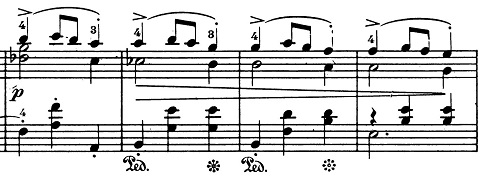
Listen carefully to the half note in the right-hand accompaniment and the quarter note on the third beat in measure 9 all the way through. However, remember that the melody is the main focus, so be careful not to overpower it.
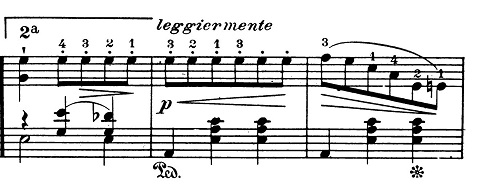
From measure 21, a new melody begins. This section often features consecutive eighth notes repeating the same tone.
In my score, the fingerings for these eighth notes are as follows: for measure 22, use “3-2-3-2-3-2,” alternating between the middle and index fingers; and for measures 24 and 26, use “3-1-3-1-3-1,” alternating between the middle and thumb.
The scores shown here and the ones from Zen-On editions suggest “3-2-1-3-2-1” as the fingering, but depending on how it is played, the eighth notes may end up sounding like sets of three. To maintain the 3/4 rhythm, I recommend alternating fingers.
Of course, this varies depending on personal preference, but I tried both and found the Paderewski edition better suited for me.
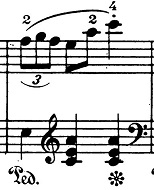
In measure 27, the Paderewski edition suggests fingering the right-hand melody as “2-3-1-2-3-5,” but I adjusted it to “1-3-1-2-3-5” for easier playing.
This not only made it more comfortable to play but also allowed me to emphasize the first beat more effectively by using the thumb, which naturally applies more weight.
This is not necessarily the correct way, but I hope it provides some inspiration for you.

Starting from measure 70, we transition into another new section. Imagine dividing it into two-measure phrases.
The two eighth notes followed by an A-flat quarter note in each phrase should remain subtle and blend into the melody, rather than standing out.
For this part, I used the fingering “3-2-1.”

From measure 119, the melody becomes less elegant and more powerful. Be conscious of the rests in the right-hand melody.
This section is marked “con anima,” meaning to play vividly or with life. So, play boldly as if singing from the depths of your being.

From measure 136, the passage is adorned with continuous grace notes.
Unlike the con anima section earlier, this part should be played with a slightly uneasy feeling, yet still lightly and gracefully.
Remember, grace notes are merely decorative. Play them as embellishments that enhance the quarter notes without overshadowing them.

From measure 169, the dolce marking appears. This marking means to play in a sweet, charming manner, so adjust your expression accordingly.
Additionally, the legato phrasing of the melody becomes a bit intricate here, so pay close attention while playing.
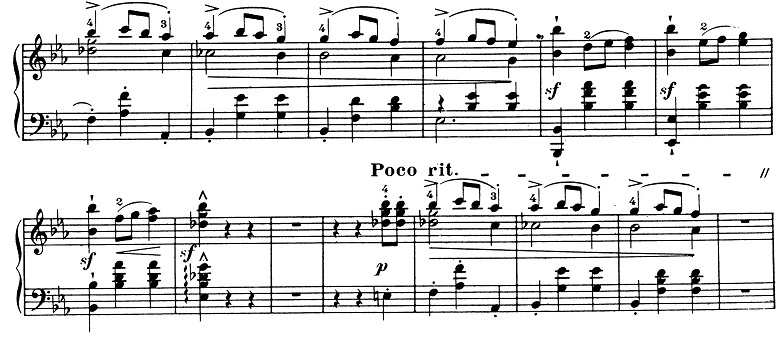
From measure 233, the first beat is marked with sforzando, emphasizing the first beat even more prominently.
Instead of relying solely on finger strength, try to engage your core muscles. Visualize sharply exhaling from your abdomen as you play.
For the chord in measure 236, consider breaking it into an arpeggio-like motion for a more flowing effect.
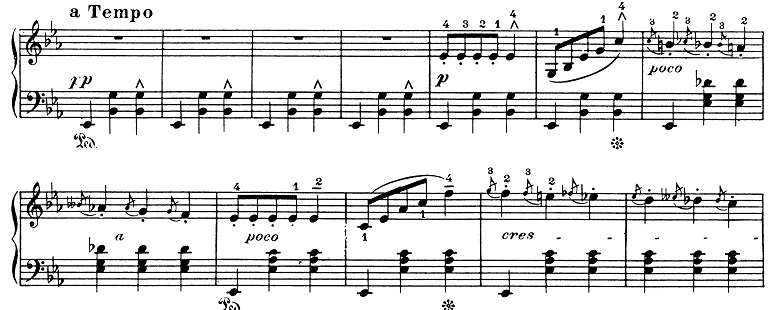
From measure 247 to the fortissimo in measure 263, the dynamics gradually build through repeated diminuendo and crescendo.

At measure 263, the fortissimo marks the pinnacle of this waltz! Play it with excitement and a sense of thrill.

From measure 287 to the end, the eighth notes suggest the conclusion of the waltz.
However, the final three measures surprise with a powerful and brilliant ending.
Summary
1. Emphasize the first beat to maintain the waltz rhythm!2. Keep your focus throughout this long piece!
3. Experiment with fingerings that suit the different sections for ease of playing!
What did you think? As suggested by the title Grande Valse Brillante, I hope you’ll play this piece with grandeur and elegance! Please give it a try.
- IMSLP (Sheet music link)
This article was created using this sheet music. It is a public domain score published by Durand in 1915.
- How to Master Chopin’s “Grand Valse Brillante”: Difficulty Level and Essential Waltz Techniques 2017/6/2
- Play with Fingerings That Suit You! Chopin’s “Grand Valse Brillante” Difficulty and Tips for Playing 2017/6/29 ←Currently Viewing Article
- 華やかなワルツの世界!ショパン「華麗なる大円舞曲」弾き方と難易度 2017年12月6日
- Ranking Chopin’s Waltzes by Difficulty: A Piano Teacher’s Perspective 2017/3/17
- Perfect for a Piano Recital! Chopin's “Minute Waltz”: Difficulty and 3 Tips for Playing It 2017/5/25
- How to Master Chopin’s “Grand Valse Brillante”: Difficulty Level and Essential Waltz Techniques 2017/6/2
- Play with Fingerings That Suit You! Chopin’s “Grand Valse Brillante” Difficulty and Tips for Playing 2017/6/29 ←Currently Viewing Article
- How to Master Chopin's “Minute Waltz”: 8 Essential Tips and Difficulty Insights from a Mole 2017/7/6
- これで挫折知らず!ショパン『ワルツ第7番op64-2』弾き方のコツと難易度 2017年7月14日
- 華やか&叙情的!ショパン『ワルツ第14番ホ短調遺作』弾き方のコツと難易度 2017年8月6日
- ロマンティックな恋!ショパン『ワルツ第9番op.69-1』の弾き方と難易度(『別れのワルツ』『告別』) 2017年11月8日
- 華やかなワルツの世界!ショパン「華麗なる大円舞曲」弾き方と難易度 2017年12月6日
- 初めてショパンを弾く人へ!『ワルツ第10番op.69-2』の弾き方と難易度 2017年12月16日
- 子犬のワルツ。ショパンの名曲のかんたんな弾き方、難易度も解説。(ワルツ第6番変ニ長調Op.64-1) 2018年3月9日
- おすすめしたい隠れた名曲!ショパン:ワルツ第15番ホ長調遺作の弾き方と難易度 2018年3月19日
- 一音入魂!ショパン:ワルツ第3番(華麗なる円舞曲)の難易度と弾き方(Op.34-2イ短調) 2018年5月19日
- ショパン作曲『子犬のワルツ』の難易度は?弾き方を極める7つのコツ 2019年8月1日


















